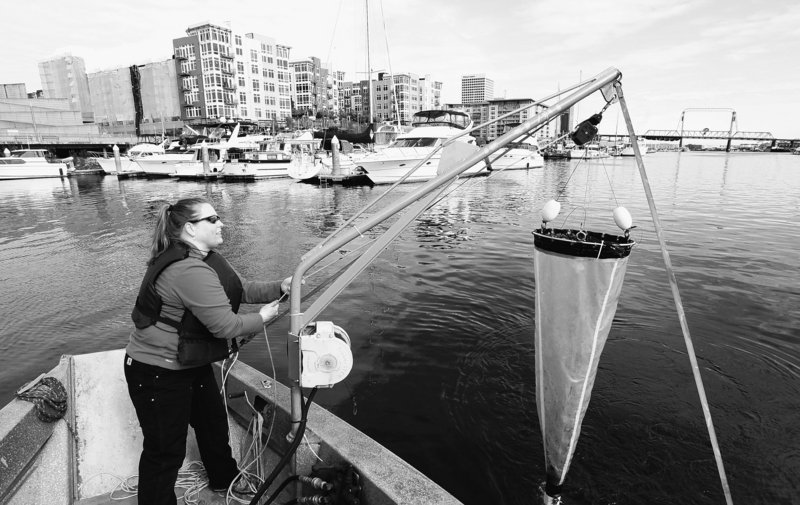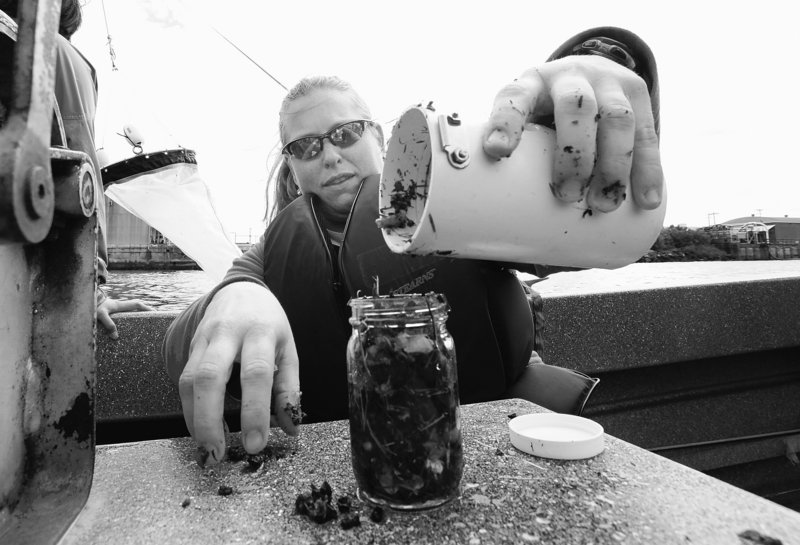TACOMA, Wash. — Motoring along the Thea Foss Waterway one morning, researcher Julie Masura dropped a fine-mesh net into the water and skimmed the surface for plastic debris.
Candy wrappers, a plastic cup, a grocery bag floated by, but the University of Washington researcher was in search of smaller items: tiny plastic particles no larger than a ladybug.
While scientists have documented the effects of large plastic flotsam in the oceans for decades – turtles trapped in fishing nets, albatrosses swallowing plastic cigarette lighters – very little research has focused on what happens when those bigger pieces break down into tiny specks, called microplastics.
“There is a surprisingly large amount of microplastics in the environment,” said Joel Baker, the Port of Tacoma Chair in Environmental Science at the University of Washington Tacoma.
Baker said microscopic fragments are floating in the ocean and washing up on shores, but the exact consequences for marine organisms are still unknown.
His project is developing methods to measure how much microplastics are in seawater and sediments, as a first step to answering those questions. They’re sampling the waters of Puget Sound and using citizen scientists to help collect plastics that wash up on beaches.
The National Oceanic and Atmospheric Administration’s Marine Debris Program is funding the project as part of a national effort to examine the potential harmful effects of microplastics on marine ecosystems.
“Not much is truly known about microplastics, so we are starting at the beginning: how do we measure the amount in the environment?” said Megan Forbes, a NOAA spokeswoman.
Forbes said Baker’s project will help develop a standardized way of collecting, isolating and quantifying microplastic particles to be used across the U.S.
“What’s the impact? Frankly, we have no idea,” said Baker, science director of the new Center for Urban Waters in Tacoma. “The one thing we know for sure is that it doesn’t break down.”
There’s increasing concern microplastics may absorb and concentrate organic contaminants such as polychlorinated biphenyls and dioxins, and pose harm to organisms when ingested.
Two major sources include material produced for use in industrial abrasives, exfoliants and cosmetics such as body washes; and larger plastic pieces that weather down into smaller bits.
Laboratory experiments have shown that lugworms, barnacles and mussels ingest microplastics, and that microplastics are taken up by mussels.
But little is known about how chemical leaches from these particles into seawater and the full effects of microplastics on organisms, according to findings from the first international workshop on microscopic marine debris co-sponsored by NOAA and UW Tacoma in 2008.
Scientists who gathered at the workshop defined microplastics as synthetic polymers less than 5 millimeters in diameter, or small enough to pass through the gut of a bird or fish without causing blockage, Baker said.
Scientists concluded far more research was needed to understand the impacts of microplastics on marine life. Another workshop to address its potential risk is set for November.
In Puget Sound, citizen scientists with the Port Townsend Marine Science Center have been sampling sediment from beaches for Baker’s microplastic project, as well as their own study.
They’re trying to understand the extent of smaller plastics on beaches from the San Juan Islands to south Puget Sound.
“There are a lot more questions than there are answers, but by virtue of the volume we’re seeing, we’re concerned,” said Anne Murphy, executive director of Port Townsend Marine Science Center, an educational organization.
“Some of these bits of plastics you see look very much like the food that birds, fish, a whale grazing could eat,” she said. “There is a concern about what happens when it enters the food chain, or when it settles on the bottom or on the fine film of the water.”
Along the Thea Foss Waterway, UW researcher Masura pulled her net from the waters after a 15-minute tow and emptied its contents into glass jars. There was woody debris, grass clippings, and some tiny colorful specks of plastic foam and other plastic items. She bottles everything to be analyzed back at the lab.
“We’re trying to answer the question of how much,” she said.
Send questions/comments to the editors.




Success. Please wait for the page to reload. If the page does not reload within 5 seconds, please refresh the page.
Enter your email and password to access comments.
Hi, to comment on stories you must . This profile is in addition to your subscription and website login.
Already have a commenting profile? .
Invalid username/password.
Please check your email to confirm and complete your registration.
Only subscribers are eligible to post comments. Please subscribe or login first for digital access. Here’s why.
Use the form below to reset your password. When you've submitted your account email, we will send an email with a reset code.